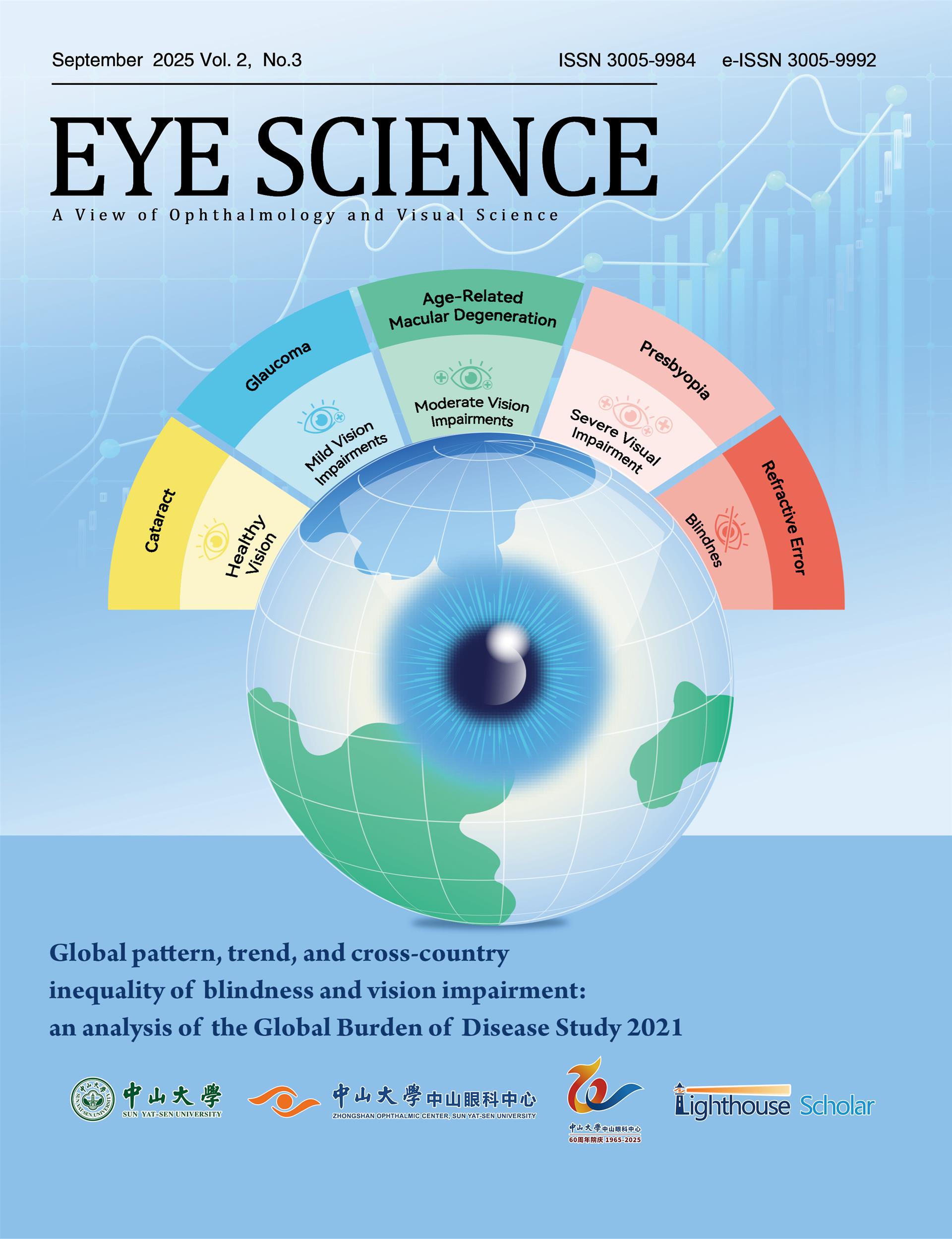1、Burton MJ, Ramke J, Marques AP, et al. The lancet global health commission on global eye health: vision beyond 2020. Lancet Glob Health. 2021, 9(4): e489-e551. DOI: 10.1016/S2214-109X(20)30488-5. Burton MJ, Ramke J, Marques AP, et al. The lancet global health commission on global eye health: vision beyond 2020. Lancet Glob Health. 2021, 9(4): e489-e551. DOI: 10.1016/S2214-109X(20)30488-5.
2、Wong B, Singh K, Everett B, et al. The case for investment in eye health: systematic review and economic modelling analysis. Bull World Health Organ. 2023, 101(12): 786-799. DOI: 10.2471/BLT.23.289863. Wong B, Singh K, Everett B, et al. The case for investment in eye health: systematic review and economic modelling analysis. Bull World Health Organ. 2023, 101(12): 786-799. DOI: 10.2471/BLT.23.289863.
3、McCarty CA, Taylor HR. Reviewing the impact of social determinants of health on rural eye care: a call to action. Clin Exp Ophthalmol. 2022, 50(5): 475-478. DOI: 10.1111/ceo.14086. McCarty CA, Taylor HR. Reviewing the impact of social determinants of health on rural eye care: a call to action. Clin Exp Ophthalmol. 2022, 50(5): 475-478. DOI: 10.1111/ceo.14086.
4、United Nations General Assembly. United Nations General Assembly Resolution 75/310. Published online July 23, 2021. Accessed February 6, 2025. United Nations General Assembly. United Nations General Assembly Resolution 75/310. Published online July 23, 2021. Accessed February 6, 2025.
5、Ma X, Zhou Z, Yi H, et al. Effect of providing free glasses on children’s educational outcomes in China: cluster randomized controlled trial. BMJ. 2014, 349: g5740. DOI: 10.1136/bmj.g5740. Ma X, Zhou Z, Yi H, et al. Effect of providing free glasses on children’s educational outcomes in China: cluster randomized controlled trial. BMJ. 2014, 349: g5740. DOI: 10.1136/bmj.g5740.
6、Piyasena P, Olvera-Herrera VO, Chan VF, et al. Vision impairment and traffic safety outcomes in low-income and middle-income countries: a systematic review and meta-analysis. Lancet Glob Health. 2021, 9(10): e1411-e1422. DOI: 10.1016/S2214-109X(21)00303-X. Piyasena P, Olvera-Herrera VO, Chan VF, et al. Vision impairment and traffic safety outcomes in low-income and middle-income countries: a systematic review and meta-analysis. Lancet Glob Health. 2021, 9(10): e1411-e1422. DOI: 10.1016/S2214-109X(21)00303-X.
7、Reddy PA, Congdon N, MacKenzie G, et al. Effect of providing near glasses on productivity among rural Indian tea workers with presbyopia (PROSPER): a randomised trial. Lancet Glob Health. 2018, 6(9): e1019-e1027. DOI: 10.1016/S2214-109X(18)30329-2. Reddy PA, Congdon N, MacKenzie G, et al. Effect of providing near glasses on productivity among rural Indian tea workers with presbyopia (PROSPER): a randomised trial. Lancet Glob Health. 2018, 6(9): e1019-e1027. DOI: 10.1016/S2214-109X(18)30329-2.
8、Sehrin F, Jin L, Naher K, et al. The effect on income of providing near vision correction to workers in Bangladesh: The THRIVE (Tradespeople and Hand-workers Rural Initiative for a Vision-enhanced Economy) randomized controlled trial. PLoS One. 2024, 19(4): e0296115. DOI: 10.1371/journal.pone.0296115. Sehrin F, Jin L, Naher K, et al. The effect on income of providing near vision correction to workers in Bangladesh: The THRIVE (Tradespeople and Hand-workers Rural Initiative for a Vision-enhanced Economy) randomized controlled trial. PLoS One. 2024, 19(4): e0296115. DOI: 10.1371/journal.pone.0296115.
9、Zhang JH, Ramke J, Jan C, et al. Advancing the Sustainable Development Goals through improving eye health: a scoping review. Lancet Planet Health. 2022, 6(3): e270-e280. DOI: 10.1016/S2542-5196(21)00351-X. Zhang JH, Ramke J, Jan C, et al. Advancing the Sustainable Development Goals through improving eye health: a scoping review. Lancet Planet Health. 2022, 6(3): e270-e280. DOI: 10.1016/S2542-5196(21)00351-X.
10、United Nations General Assembly. Transforming Our World: The 2030 Agenda for Sustainable Development. United Nations. 2015. Accessed February 6, 2025. United Nations General Assembly. Transforming Our World: The 2030 Agenda for Sustainable Development. United Nations. 2015. Accessed February 6, 2025.
11、Tan X, Han X, Zheng Y, et al. Impact of cataract surgery on income in rural Southern China: the SUCCESS randomized controlled trial. Asia Pac J Ophthalmol (Phila). 2023, 12(4): 355-363. DOI: 10.1097/APO.0000000000000624. Tan X, Han X, Zheng Y, et al. Impact of cataract surgery on income in rural Southern China: the SUCCESS randomized controlled trial. Asia Pac J Ophthalmol (Phila). 2023, 12(4): 355-363. DOI: 10.1097/APO.0000000000000624.
12、Krugman P. Productivity growth. In: The age of diminished expectations. In: MIT; 1997:11-20.Krugman P. Productivity growth. In: The age of diminished expectations. In: MIT; 1997:11-20.
13、Lowder%20SK%2C%20S%C3%A1nchez%20MV%2C%20Bertini%20R.%20Which%20farms%20feed%20the%20world%20and%20has%20farmland%20become%20more%20concentrated%3F%20World%20Dev.%202021%2C%20142%3A%20105455.%20DOI%3A%2010.1016%2Fj.worlddev.2021.105455.Lowder%20SK%2C%20S%C3%A1nchez%20MV%2C%20Bertini%20R.%20Which%20farms%20feed%20the%20world%20and%20has%20farmland%20become%20more%20concentrated%3F%20World%20Dev.%202021%2C%20142%3A%20105455.%20DOI%3A%2010.1016%2Fj.worlddev.2021.105455.
14、Ricciardi%20V%2C%20Ramankutty%20N%2C%20Mehrabi%20Z%2C%20et%20al.%20How%20much%20of%20the%20world%E2%80%99s%20food%20do%20smallholders%20produce%3F%20Glob%20Food%20Secur.%202018%2C%2017%3A%2064-72.%20DOI%3A%2010.1016%2Fj.gfs.2018.05.002.%20Ricciardi%20V%2C%20Ramankutty%20N%2C%20Mehrabi%20Z%2C%20et%20al.%20How%20much%20of%20the%20world%E2%80%99s%20food%20do%20smallholders%20produce%3F%20Glob%20Food%20Secur.%202018%2C%2017%3A%2064-72.%20DOI%3A%2010.1016%2Fj.gfs.2018.05.002.%20
15、 Boccardo L, Gurioli M, Grasso PA. Viewing distance and character size in the use of smartphones across the lifespan. PLoS One. 2023, 18(4): e0282947. DOI: 10.1371/journal.pone.0282947. Boccardo L, Gurioli M, Grasso PA. Viewing distance and character size in the use of smartphones across the lifespan. PLoS One. 2023, 18(4): e0282947. DOI: 10.1371/journal.pone.0282947.
16、Wang C, Wang X, Jin L, et al. Influence of presbyopia on smartphone usage among Chinese adults: a population study. Clin Exp Ophthalmol. 2019, 47(7): 909-917. DOI: 10.1111/ceo.13559. Wang C, Wang X, Jin L, et al. Influence of presbyopia on smartphone usage among Chinese adults: a population study. Clin Exp Ophthalmol. 2019, 47(7): 909-917. DOI: 10.1111/ceo.13559.
17、Shitol SA, Aftab IB, Piyasena P, et al. Transforming households with refraction and innovative financial technology (THRIFT): study protocol for a randomised controlled trial of vision interventions and online banking among the elderly in kurigram. BMJ Open. 2024, 14(12): e085083. DOI: 10.1136/bmjopen-2024-085083. Shitol SA, Aftab IB, Piyasena P, et al. Transforming households with refraction and innovative financial technology (THRIFT): study protocol for a randomised controlled trial of vision interventions and online banking among the elderly in kurigram. BMJ Open. 2024, 14(12): e085083. DOI: 10.1136/bmjopen-2024-085083.
18、Shivakumar M, Welsh V, Bajpai R, et al. Musculoskeletal disorders and pain in agricultural workers in Low- and Middle-Income Countries: a systematic review and meta-analysis. Rheumatol Int. 2024, 44(2): 235-247. DOI: 10.1007/s00296-023-05500-5. Shivakumar M, Welsh V, Bajpai R, et al. Musculoskeletal disorders and pain in agricultural workers in Low- and Middle-Income Countries: a systematic review and meta-analysis. Rheumatol Int. 2024, 44(2): 235-247. DOI: 10.1007/s00296-023-05500-5.
19、Gebrye T, Mbada C, Apeagyei P, et al. Prevalence of musculoskeletal disorders among garment workers: a systematic review and meta-analysis. BMJ Open. 2025, 15(1): e085123. DOI: 10.1136/bmjopen-2024-085123. Gebrye T, Mbada C, Apeagyei P, et al. Prevalence of musculoskeletal disorders among garment workers: a systematic review and meta-analysis. BMJ Open. 2025, 15(1): e085123. DOI: 10.1136/bmjopen-2024-085123.
20、Khanna RC, Murthy GVS, Giridhar P, et al. Cataract, visual impairment and long-term mortality in a rural cohort in India: the Andhra Pradesh Eye Disease Study. PLoS One. 2013, 8(10): e78002. DOI: 10.1371/journal.pone.0078002. Khanna RC, Murthy GVS, Giridhar P, et al. Cataract, visual impairment and long-term mortality in a rural cohort in India: the Andhra Pradesh Eye Disease Study. PLoS One. 2013, 8(10): e78002. DOI: 10.1371/journal.pone.0078002.
21、Kuper H, Mathenge W, MacLeod D, et al. Mortality during 6 years of follow-up in relation to visual impairment and eye disease: results from a population-based cohort study of people aged 50 years and above in Nakuru, Kenya. BMJ Open. 2019, 9(6): e029700. DOI: 10.1136/bmjopen-2019-029700. Kuper H, Mathenge W, MacLeod D, et al. Mortality during 6 years of follow-up in relation to visual impairment and eye disease: results from a population-based cohort study of people aged 50 years and above in Nakuru, Kenya. BMJ Open. 2019, 9(6): e029700. DOI: 10.1136/bmjopen-2019-029700.
22、Pellegrini M, Bernabei F, Schiavi C, et al. Impact of cataract surgery on depression and cognitive function: Systematic review and meta-analysis. Clin Exp Ophthalmol. 2020, 48(5): 593-601. DOI: 10.1111/ceo.13754. Pellegrini M, Bernabei F, Schiavi C, et al. Impact of cataract surgery on depression and cognitive function: Systematic review and meta-analysis. Clin Exp Ophthalmol. 2020, 48(5): 593-601. DOI: 10.1111/ceo.13754.
23、Patel V, Saxena S, Lund C, et al. The Lancet Commission on global mental health and sustainable development. Lancet. 2018, 392(10157): 1553-1598. DOI: 10.1016/S0140-6736(18)31612-X. Patel V, Saxena S, Lund C, et al. The Lancet Commission on global mental health and sustainable development. Lancet. 2018, 392(10157): 1553-1598. DOI: 10.1016/S0140-6736(18)31612-X.
24、 Li D, Chan VF, Virgili G, et al. Impact of vision impairment and ocular morbidity and their treatment on depression and anxiety in children: a systematic review. Ophthalmology. 2022, 129(10): 1152-1170. DOI: 10.1016/j.ophtha.2022.05.020. Li D, Chan VF, Virgili G, et al. Impact of vision impairment and ocular morbidity and their treatment on depression and anxiety in children: a systematic review. Ophthalmology. 2022, 129(10): 1152-1170. DOI: 10.1016/j.ophtha.2022.05.020.
25、Li D, Chan VF, Virgili G, et al. Impact of vision impairment and ocular morbidity and their treatment on quality of life in children: a systematic review. Ophthalmology. 2024, 131(2): 188-207. DOI: 10.1016/j.ophtha.2023.09.005. Li D, Chan VF, Virgili G, et al. Impact of vision impairment and ocular morbidity and their treatment on quality of life in children: a systematic review. Ophthalmology. 2024, 131(2): 188-207. DOI: 10.1016/j.ophtha.2023.09.005.
26、Nagarajan N, Assi L, Varadaraj V, et al. Vision impairment and cognitive decline among older adults: a systematic review. BMJ Open. 2022, 12(1): e047929. DOI: 10.1136/bmjopen-2020-047929. Nagarajan N, Assi L, Varadaraj V, et al. Vision impairment and cognitive decline among older adults: a systematic review. BMJ Open. 2022, 12(1): e047929. DOI: 10.1136/bmjopen-2020-047929.
27、Varadaraj V, Munoz B, Deal JA, et al. Association of vision impairment with cognitive decline across multiple domains in older adults. JAMA Netw Open. 2021, 4(7): e2117416. DOI: 10.1001/jamanetworkopen.2021.17416. Varadaraj V, Munoz B, Deal JA, et al. Association of vision impairment with cognitive decline across multiple domains in older adults. JAMA Netw Open. 2021, 4(7): e2117416. DOI: 10.1001/jamanetworkopen.2021.17416.
28、Kuriakose RK, Khan Z, Almeida DRP, et al. Depression and burden among the caregivers of visually impaired patients: a systematic review. Int Ophthalmol. 2017, 37(3): 767-777. DOI: 10.1007/s10792-016-0296-2. Kuriakose RK, Khan Z, Almeida DRP, et al. Depression and burden among the caregivers of visually impaired patients: a systematic review. Int Ophthalmol. 2017, 37(3): 767-777. DOI: 10.1007/s10792-016-0296-2.
29、Marmamula S, Alladi S, Umapathy K, et al. Cognitive level enhancement through vision exams and refraction (CLEVER): study protocol for a randomised controlled trial. Trials. 2025, 26(1): 109. DOI: 10.1186/s13063-025-08813-x. Marmamula S, Alladi S, Umapathy K, et al. Cognitive level enhancement through vision exams and refraction (CLEVER): study protocol for a randomised controlled trial. Trials. 2025, 26(1): 109. DOI: 10.1186/s13063-025-08813-x.
30、Wimo A, Guerchet M, Ali GC, et al. The worldwide costs of dementia 2015 and comparisons with 2010. Alzheimers Dement. 2017, 13(1): 1-7. DOI: 10.1016/j.jalz.2016.07.150. Wimo A, Guerchet M, Ali GC, et al. The worldwide costs of dementia 2015 and comparisons with 2010. Alzheimers Dement. 2017, 13(1): 1-7. DOI: 10.1016/j.jalz.2016.07.150.
31、Mattap SM, Mohan D, McGrattan AM, et al. The economic burden of dementia in low- and middle-income countries (LMICs): a systematic review. BMJ Glob Health. 2022, 7(4): e007409. DOI: 10.1136/bmjgh-2021-007409. Mattap SM, Mohan D, McGrattan AM, et al. The economic burden of dementia in low- and middle-income countries (LMICs): a systematic review. BMJ Glob Health. 2022, 7(4): e007409. DOI: 10.1136/bmjgh-2021-007409.
32、Jotheeswaran SK, Girish, Bharath S, Dias A, et al. The
Dementia India rreport 2010 Prevalence, Impact, Costs
and Services for Dementia A Report Prepared for the
Alzheimer's and Related Disorders Society of India. 2010.
Accessed February 13, 2025. https://api.semanticscholar.
org/CorpusID:45379329.Jotheeswaran SK, Girish, Bharath S, Dias A, et al. The
Dementia India rreport 2010 Prevalence, Impact, Costs
and Services for Dementia A Report Prepared for the
Alzheimer's and Related Disorders Society of India. 2010.
Accessed February 13, 2025. https://api.semanticscholar.
org/CorpusID:45379329.
33、Rao%20GN%2C%20Bharath%20S.%20Cost%20of%20dementia%20care%20in%20India%3A%20delusion%20or%20reality%3F%20Indian%20J%20Public%20Health.%202013%2C%2057(2)%3A%2071-77.%20DOI%3A%2010.4103%2F0019-557X.114986.%20Rao%20GN%2C%20Bharath%20S.%20Cost%20of%20dementia%20care%20in%20India%3A%20delusion%20or%20reality%3F%20Indian%20J%20Public%20Health.%202013%2C%2057(2)%3A%2071-77.%20DOI%3A%2010.4103%2F0019-557X.114986.%20
34、Dhakhwa P, Everett B, Wong B. Better Education in Sight. An Estimate of Global Learning and Economic Productivity Losses from Uncorrected Refractive Error in Schools. IAPB. 2024. Accessed February 17, 2025.Dhakhwa P, Everett B, Wong B. Better Education in Sight. An Estimate of Global Learning and Economic Productivity Losses from Uncorrected Refractive Error in Schools. IAPB. 2024. Accessed February 17, 2025.
35、Glewwe P, Park A, Zhao M. A better vision for development: eyeglasses and academic performance in rural primary schools in China. J Dev Econ. 2016, 122: 170-182. DOI: 10.1016/j.jdeveco.2016.05.007. Glewwe P, Park A, Zhao M. A better vision for development: eyeglasses and academic performance in rural primary schools in China. J Dev Econ. 2016, 122: 170-182. DOI: 10.1016/j.jdeveco.2016.05.007.
36、Ma Y, Congdon N, Shi Y, et al. Effect of a local vision care center on eyeglasses use and school performance in rural China: a cluster randomized clinical trial. JAMA Ophthalmol. 2018, 136(7): 731-737. DOI: 10.1001/jamaophthalmol.2018.1329. Ma Y, Congdon N, Shi Y, et al. Effect of a local vision care center on eyeglasses use and school performance in rural China: a cluster randomized clinical trial. JAMA Ophthalmol. 2018, 136(7): 731-737. DOI: 10.1001/jamaophthalmol.2018.1329.
37、Glewwe P, West KL, Lee J. The impact of providing vision screening and free eyeglasses on academic outcomes: evidence from a randomized trial in title I elementary schools in Florida. J Policy Anal Manage. 2018, 37(2): 265-300. DOI: 10.1002/pam.22043. Glewwe P, West KL, Lee J. The impact of providing vision screening and free eyeglasses on academic outcomes: evidence from a randomized trial in title I elementary schools in Florida. J Policy Anal Manage. 2018, 37(2): 265-300. DOI: 10.1002/pam.22043.
38、Hark LA, Thau A, Nutaitis A, et al. Impact of eyeglasses on academic performance in primary school children. Can J Ophthalmol. 2020, 55(1): 52-57. DOI: 10.1016/j.jcjo.2019.07.011. Hark LA, Thau A, Nutaitis A, et al. Impact of eyeglasses on academic performance in primary school children. Can J Ophthalmol. 2020, 55(1): 52-57. DOI: 10.1016/j.jcjo.2019.07.011.
39、Neitzel AJ, Wolf B, Guo X, et al. Effect of a randomized interventional school-based vision program on academic performance of students in grades 3 to 7: a cluster randomized clinical trial. JAMA Ophthalmol. 2021, 139(10): 1104-1114. DOI: 10.1001/jamaophthalmol.2021.3544. Neitzel AJ, Wolf B, Guo X, et al. Effect of a randomized interventional school-based vision program on academic performance of students in grades 3 to 7: a cluster randomized clinical trial. JAMA Ophthalmol. 2021, 139(10): 1104-1114. DOI: 10.1001/jamaophthalmol.2021.3544.
40、Baruwa E, Tzu J, Congdon N, et al. Reversal in gender valuations of cataract surgery after the implementation of free screening and low-priced high-quality surgery in a rural population of Southern China. Ophthalmic Epidemiol. 2008, 15(2): 99-104. DOI: 10.1080/09286580801999118. Baruwa E, Tzu J, Congdon N, et al. Reversal in gender valuations of cataract surgery after the implementation of free screening and low-priced high-quality surgery in a rural population of Southern China. Ophthalmic Epidemiol. 2008, 15(2): 99-104. DOI: 10.1080/09286580801999118.
41、Mercer GD, Lyons P, Bassett K. Interventions to improve gender equity in eye care in low-middle income countries: a systematic review. Ophthalmic Epidemiol. 2019, 26(3): 189-199. DOI: 10.1080/09286586.2019.1574839. Mercer GD, Lyons P, Bassett K. Interventions to improve gender equity in eye care in low-middle income countries: a systematic review. Ophthalmic Epidemiol. 2019, 26(3): 189-199. DOI: 10.1080/09286586.2019.1574839.
42、World Health Organization. Global Status Report on Road Safety 2015.; 2015. Accessed February 6, 2025.World Health Organization. Global Status Report on Road Safety 2015.; 2015. Accessed February 6, 2025.
43、Swain TA, McGwin G Jr, Wood JM, et al. Naturalistic driving techniques and association of visual risk factors with at-fault crashes and near crashes by older drivers with vision impairment. JAMA Ophthalmol. 2021, 139(6): 639-645. DOI: 10.1001/jamaophthalmol.2021.0862.Swain TA, McGwin G Jr, Wood JM, et al. Naturalistic driving techniques and association of visual risk factors with at-fault crashes and near crashes by older drivers with vision impairment. JAMA Ophthalmol. 2021, 139(6): 639-645. DOI: 10.1001/jamaophthalmol.2021.0862.
44、Owsley C, McGwin G Jr, Searcey K. A population-based examination of the visual and ophthalmological characteristics of licensed drivers aged 70 and older. J Gerontol A Biol Sci Med Sci. 2013, 68(5): 567-573. DOI: 10.1093/gerona/gls185. Owsley C, McGwin G Jr, Searcey K. A population-based examination of the visual and ophthalmological characteristics of licensed drivers aged 70 and older. J Gerontol A Biol Sci Med Sci. 2013, 68(5): 567-573. DOI: 10.1093/gerona/gls185.
45、Wood JM, Black AA, Dingle K, et al. Impact of vision disorders and vision impairment on motor vehicle crash risk and on-road driving performance: a systematic review. Acta Ophthalmol. 2022, 100(2): e339-e367. DOI: 10.1111/aos.14908. Wood JM, Black AA, Dingle K, et al. Impact of vision disorders and vision impairment on motor vehicle crash risk and on-road driving performance: a systematic review. Acta Ophthalmol. 2022, 100(2): e339-e367. DOI: 10.1111/aos.14908.
46、Le VC, To KG, Le VD, et al. STABLE trial of spectacle provision and driving safety among myopic motorcycle users in Vietnam: study protocol for a stepped-wedge, cluster randomised trial. Trials. 2024, 25(1): 825. DOI: 10.1186/s13063-024-08644-2.Le VC, To KG, Le VD, et al. STABLE trial of spectacle provision and driving safety among myopic motorcycle users in Vietnam: study protocol for a stepped-wedge, cluster randomised trial. Trials. 2024, 25(1): 825. DOI: 10.1186/s13063-024-08644-2.


























